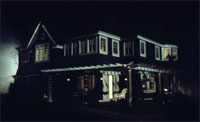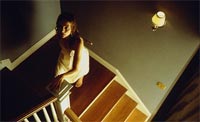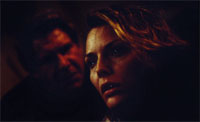
Quelle "Diabolique"! A thrilling-horror-film appears on the silver screen once again.
In the sedate surroundings of rural Vermont, life seems peaceful in the household of
Claire Spencer (Michelle Pfeiffer) and her brilliant scientist husband, Norman
(Harrison Ford). Disturbed only by the violent arguments of a couple that have
recently moved in next door, peace apparently resumes once again after the
neighbors enjoy a hefty (and noisy) romantic tumble in the bedroom.
What Lies Beneath
©Twentieth Century Fox and DreamWorks Pictures

|
After noticing odd goings-on next door one rainy night (through her "Rear Window"),
Claire is convinced that Mr. Feuer has murdered his wife. Her suspicion takes such a
hold upon her mind that she begins vigorously pursuing the enigmatic trail that might
reveal the truth. Her feelings of anxiety are not lessened by a number of
incomprehensible and unexplainable activities recently taking place within her own
home (such as doors that open by themselves, a picture frame that knocks itself
over, and a computer that turns itself on and off at will). Strange events are almost
hoisted in her direction, but one can never be sure if they are really taking place or
merely figments of her imagination.
Norman listens to her suspicions, but seemingly takes it all with a grain of salt. She
hasn't really been the same person since a car accident one-year earlier and these
apparitions and suspicions could well be the result of her trauma. Claire is convinced
that a dead woman, who now begins appearing to her, is the neighbor's wife and
decides it is her responsibility to follow the constant trail of clues. Little does she
know the number of surprises that are in store for her. She has been given the key to
solve a problem and must follow through until she unlocks the truth.
What Lies Beneath
©Twentieth Century Fox and DreamWorks Pictures

|
The plot line of the initial half-hour might lead one to suspect this film follows in the
footsteps of recent attractions like "The Sixth Sense," or "Stir of Echoes," but the
anticipation of copy-cat plotline is quickly eradicated when the story begins taking
other twists and turns than anticipated. It is a slow-paced tale (as well it should be)
enhanced by the glances, moods, thoughts and interactions of Pfeiffer and Ford.
Michelle Pfeiffer, especially, manages to subtly reflect all the thoughts and anxieties
that her character undergoes while unintentionally growing involved with the events
and apparitions that torment her.
Several aspects of this film bring the 1961 Michael Anderson film "The Naked Edge"
to mind. Although this earlier film, starring Deborah Kerr and Gary Cooper (in his last
screen role), has many fascinating elements, it never really managed to pull it off
successfully as a thriller. Among other things, the bathroom is a central image in
both films and the suspense is superbly maintained by remarkable performances of
both leading actors. One of the unfortunate points of the earlier film was the
awkward development of the plot line followed by a weak (throwaway) ending. "What
What Lies Beneath
©Twentieth Century Fox and DreamWorks Pictures

|
Lies Beneath" manages to show what this kind of thriller can be like when intelligently
approached and properly worked out. The tension built is masterfully crafted
throughout the film and the twists and turns in the story never suffer from the
creaking plot forces prevalent in many other films of this ilk (e.g. Brian G Hutton's
1973 "Night Watch" starring Elizabeth Taylor and Laurence Harvey, based upon a
Lucille Fletcher play). The final minutes of the film are, perhaps, milked more than
necessary when approaching the final moments, but that has become almost
incredibly mandatory since the days when Brian De Palma created his final thrills in
"Carrie." And then, of course, there's "Psycho."
Director Robert Zemeckis feels that "Audiences today are very hip and savvy to the
conventions of the genre, so you have to go beyond them." In referring to "What Lies
Beneath," he explains that, "Everything in the movie had to work on two layers.
Depending on how you look at something, it can be beautiful or an instrument of
terror, which is one of the great devices for a scary movie."
Production designers Rick Carter and Jim Teegarten have balanced the constant
threat of impending disaster with the beautiful and peaceful whites and blues of the
surroundings, both inside and out. The location of the story is a rustic perfection that
turns into a restless nightmare. They designed a Nantucket-style shingled house that
was constructed as a real two-story structure with a wooden dock leading to the
water *. (The house of the couple next door was also designed and built.)
Visual effects supervisor Rob Legato (Academy Award ® winner for his work on
"Titanic") has surpassed himself in the subtlety with which he has realized the
demands made by the script. "I've always felt that visual effects should be built into
the fabric of the movie, and as such should enhance the story, not draw you out of it.
And in a film like this, my job is to make the effects even more seamless than in, say,
a science fiction film. They should almost breeze by, and you'd never know that I
had a hand in the film at all."
What Lies Beneath
©Twentieth Century Fox and DreamWorks Pictures

|
DP Don Burgess increases the tension as he maneuvers through the sets. The lens
takes an increasingly lower angle whenever the fear intensifies and one can almost
cut the atmosphere found in this mysterious house of mirrors. Although there are
images irrefutably pulled straight out of Clouzot, Hitchcock, and Anderson, all of this
fades in importance (along with the misty hallways) next to the masterful way the
camera is handled by Burgess. The image of water is, after all, an integral element
of the story and fits suitably into the images presented. This couple lives on the
water's edge and water remains both symbolic of birth and death. The mystery of the
unknown reveals itself deliciously, step by step, until the piecemeal puzzle is
completed. (This is especially due to the clever structure of Clark Gregg's screenplay
based upon a story by himself and Sarah Kernochan.)
It would be easy to tell more about the story, but it would give too much away. As
Zemeckis says, "I think the enjoyment of the movies like this comes from not knowing
what to expect."
Pretend you're floating in the lake. Sit back and relax. Go with the flow.
* Both the interior and exterior of the Vermont home were duplicated on soundstages in L.A. which
permitted extra flexibility for camera activity as well as action and effects. The notorious bathroom, for
example, was created in five versions. As Carter explains, "The Spencer house has to appear first as
a seemingly perfect home for the perfect couple, but as the story progresses it evolves into something
more sinister. Jim (Teegarten) and I spent a long time working out every detail. For example, we
used a specific shade of blue on the interior that, with the right light, can appear very nice and bright,
but takes on another feeling as things become darker and more threatening."
© 1994-2006 The Green Hartnett
|

